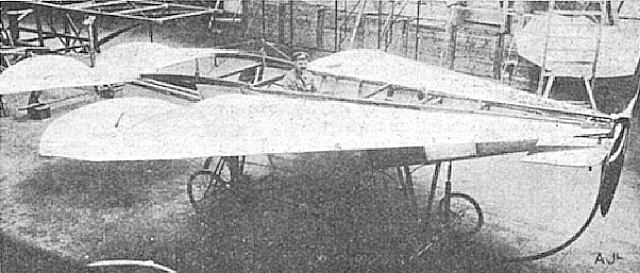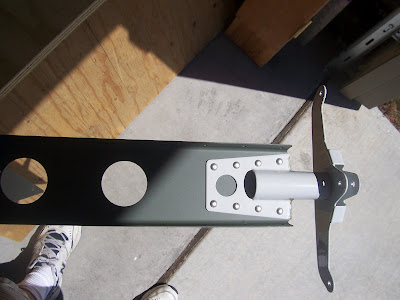Next up for assembly is the airplane rudder skeleton. There's a rivet issue here that gave me some trouble so new RV-12 builders should take heed. First I'll insert the work photos so it makes sense:
For readers who aren't RV-12 builders, the trapezoid-looking thingys are called spar caps. They provide a place to mount one of the two rudder hinges and give the rudder spar additional strength. It's also where the first rib goes. You match-drill and debur the holes and then rivet them in with 14 rivets each using different sized rivets.
Here's the two halves of the rudder hinge riveted in with four rivets each. Click on the photos to make 'em bigger if your eyesight, like mine, isn't what it used to be, or you have a small computer monitor.
This is the opposite side of the rudder spar with the rib sticking up. These are the shop side of the rivets, the part of the rivet that gets squished by the rivet squeezer to create the grip, fixing the pieces together. Getting the squeeze just right is a bit of an art-- it helps to know what properly-squeezed and improperly-squeezed rivets look like and why it matters. The builders manual has a whole section on that. I should probably read it.
And here's another picture of the shop side of the squeezed rivets. The bottom row of rivets are ones connecting the rudder hinge to the spar and spar caps. The next row are the ones connecting the rib to the spar and spar caps. The aluminum hinge is thicker than the aluminum rib, but the plans use the same rivet size for both.
All very straight forward, yes? Well no, it wasn't. No way Jos
é. Fortunately other RV-12 builder blogs like Dave G's
Schmetterling Aviation give fair warning regarding the rivet lengths in this section of the build. Basically the warning goes like this: Owing to the different thicknesses of aluminum, the rivet length is correct for riveting the hinges, but not for riveting the rib. It won't squeeze right, 'cause that's what rivets do when they're too long for the pieces being fastened. Proceeding very cautiously on the first rivet I squeezed a little bit from the right side, then a little from the left, then a little from the right... eventually I got a squeezed rivet that will do the job, but will forever be a tiny bit canted. I could drill it out and do it again, but it's builder's discretion; based on my limited knowledge regarding riveting thin aluminum airplane parts, I'm likely to do more harm than good by possibly enlarging the hole. Having confirmed Dave G's warning about the rivet lengths, the solution for the next three rivets was easy: shorten the length of the rivet with a ScotchBrite wheel on the bench grinder. Once I ground off about a millimeter or so, then cautiously squeezing from the left, then the right, then a little more from the left, and so on, the rest turned out okay. So this was another case where 12 rivets took, oh, two hours. I wonder if other people are this slow? It would have been a lot longer without the heads-up from other builders and to them I am grateful. Thanks Dave!

























